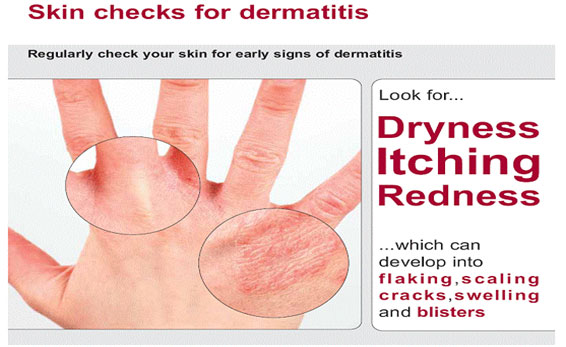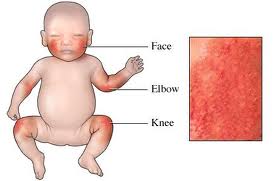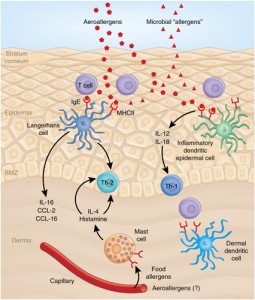Atopic dermatitis is a chronic (long-lasting) skin disorder and is non-contagious in nature i.e. it cannot be passed from one person to another. The word “dermatitis” means inflammation of the skin. “Atopic” comes form the word “Atopy” that includes a group of diseases in which there is an inherited tendency to develop allergic conditions.
In Atopic dermatitis, the skin becomes extremely itchy. On scratching the affected parts there may be redness, swelling, cracking, oozing of clear fluid, crusting and scaling. This entire sequence occurs as a gradual process and all of these may not always be seen at the same time.

During the course of the disease there may be periods when the disease becomes worse; such periods are called flare-ups or exacerbations. Then there may also be periods when the skin symptoms improve or clears up completely and such periods are called remissions.
How homoeopathy helps Atopic dermatitis ?
Children with Atopic dermatitis find an excellent treatment with homeopathy. Just like any other immunological disease, here too, earlier the better. Also, cases before using the cortisone respond better( faster) than those who are on cortisone, especially for a long time.
Causes
The exact cause of Atopic dermatitis is not known, recent studies suggests a disordered immune response, especially an imbalance of cytokines (proteins used by immune cells and other cells to communicate) as probable cause of Atopic dermatitis.
In two third of the patients a positive family history of Atopic ailments like asthma, allergic rhinitis, including Atopic dermatitis has been found confirming its hereditary origin.
It can be said that Atopic Dermatitis is essentially caused genetic tendency, supported by allergic response which has immunological factors involved in the process; which could be triggered by certain factors shown here.
Triggering factors:
- Conditions that dry the skin:
- Excessive bathing
- Washing hands frequently
- Sweating
- Swimming
- Licking lips frequently
- Excessive exposure to heat/cold: Hot showers/baths
- Over-dressing
- Using electric blankets, heating pads
- Emotional stress
- Contact with cosmetics, detergents, deodorants and soaps can exacerbate the illness
- Exposure to high humidity
- Tight fitted clothes can constantly rub the skin and cause dermatitis
- Recurrent skin infections
- Exposure to certain foods, typically eggs, peanuts, milk, soy, wheat products, etc. Many children with moderate to severe Atopic dermatitis also have some type of food allergy. However, experts do not agree on whether foods can cause Atopic dermatitis.
Symptoms
Atopic dermatitis presents with inflamed skin. The typical rash or eruptions are dry, scaly, red and with itching. The skin eruptions could affect any part of the body, however, it is more common on face, folds of hands and feet. The predominant symptom of Atopic dermatitis is intense itching. Thin watery discharge may ooze after itching. There may also be minor bleeding on scratching. Some of the lesions might get infected by contamination with bacteria, leading to pus formation.
Most of the patients which are treated conventionally with the use of cortisone in the form of topical cream or oral tablets; have a tendency to
get suppressed. The patient and parents might get a sign of relief, least realizing that the effect of cortisone is only superficially and the disease will come back with vengeance.
It is a common phenomenon that patients tend to keep on using cortisone, masking the disease, and the disease goes deeper and deeper.
Dermatological distribution of the skin lesions as per age:
Infants
In infants symmetric lesions are found over face (cheeks, forehead, scalp, and trunk), on the outer surface (extensor) of the extremities, scalp (sometimes causing alopecia). In extensive cases rash can be found even on the flexor surfaces of the extremities.
Children
There is presence of symmetric lesions on the wrist, ankles and the flexor areas of the limbs. Generalized lesions spread all over the body can also be found in this age group.
Adults
Predominantly affects the flexor areas of the arms, legs and neck. Other areas which can be affected are groin, axillary, etc.
Stages of Atopic dermatitis:
The skin lesions of Atopic dermatitis vary according to the stage of disease.
Acute stage
On examination the lesions appear wet due to serous (thin) exudates from the erosion. Papules (flat bumps) and vesicles (fluid-filled eruptions) are present on reddish skin.
Sub-acute
The characteristic features of the skin at this stage of disease are – scaling of skin, excoriated and fused papules over erythematous (red) skin.
Chronic
In chronic cases the skin is typically thickened and has pigmentary changes (hyperpigmentation or hypopigmentation). The papules are excoriated and there is presence of nodules on the skin. Intense itching is present in all stages of the disease hence the person tends to scratch all the time, this often leads to secondary infection of the lesion. As a result the lesion develops yellow crust over-laying pus and is surrounded by erythema.





